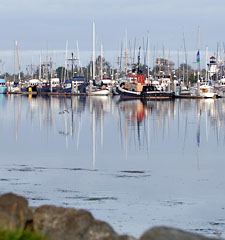With wave-generated energy being such a young technology, the focus of the forum was to look at the advantages and disadvantages of installing such a system along the north coast.
Ian Caliendo of the Pacific Gas and Electric Company presented an update of plans to conduct feasibility studies off the Humboldt and Mendocino county coasts. "The project is called WaveConnect and it differs from other wave-energy projects that have been proposed. It's a project that could test several types of devices at once and really compare and contrast technologies to see what is the most environmentally benign and captures the waves most efficiently," Caliendo said.

PG&E has applied to the Federal Energy Regulatory Commission for permits to conduct the studies but they have not yet been approved.
Dr. Greg Crawford, chair of the Department of Oceanography, explained that several climactic factors combine to make the northern California coast uniquely suited to wave generation. "We have one of the strongest wave climates over all. When you're trying to extract energy, you want a place you can do it all the time." Crawford said.
But, Dr. Crawford cautions, there is much more to it than just weather patterns. "There is a lot of concern about what the impacts might be. How much visible impact will there be? Will this disturb the ecosystem, will whales get caught up in the lines? How will this impact other business that goes on in the ocean."
The OPC is charged with the coordination of various state agencies responsible for the use and preservation of the state's oceanic resources.
The council holds regular meetings throughout the state to discuss coastal issues, including another public meeting held Thursday, Oct. 25, at Eureka's Wharfinger Building.